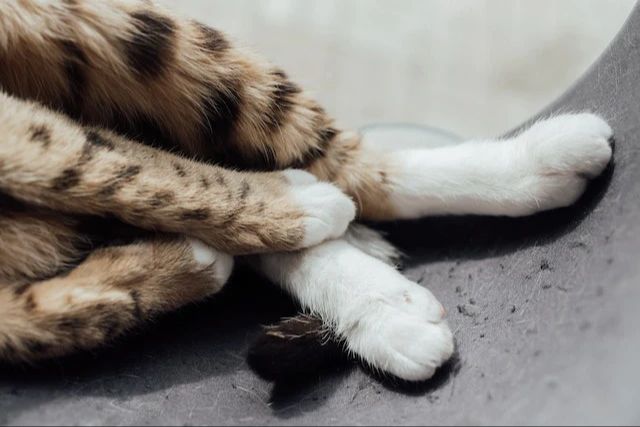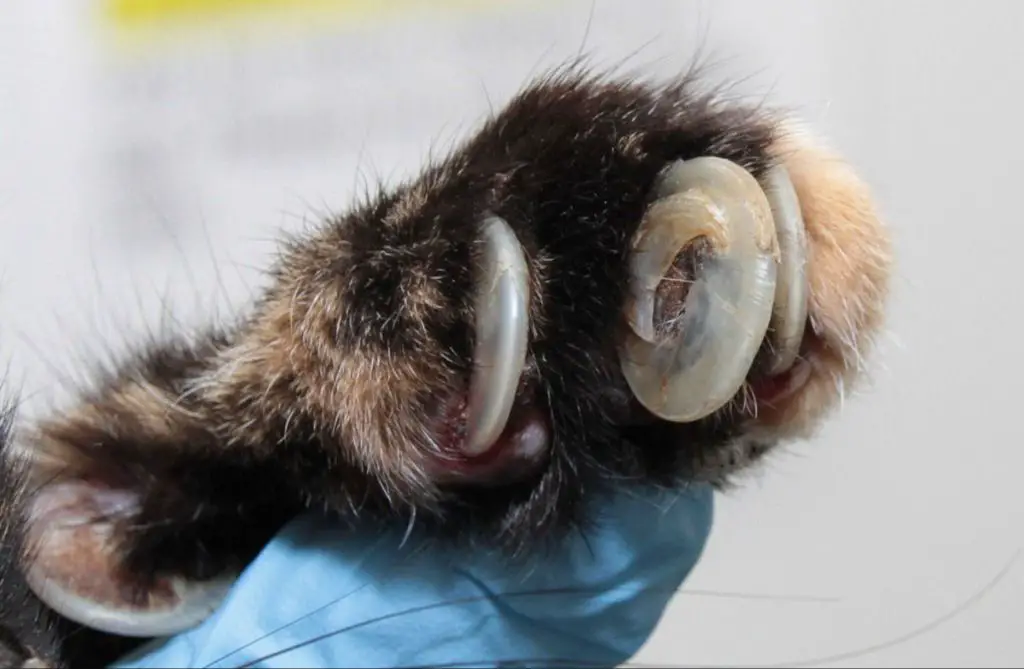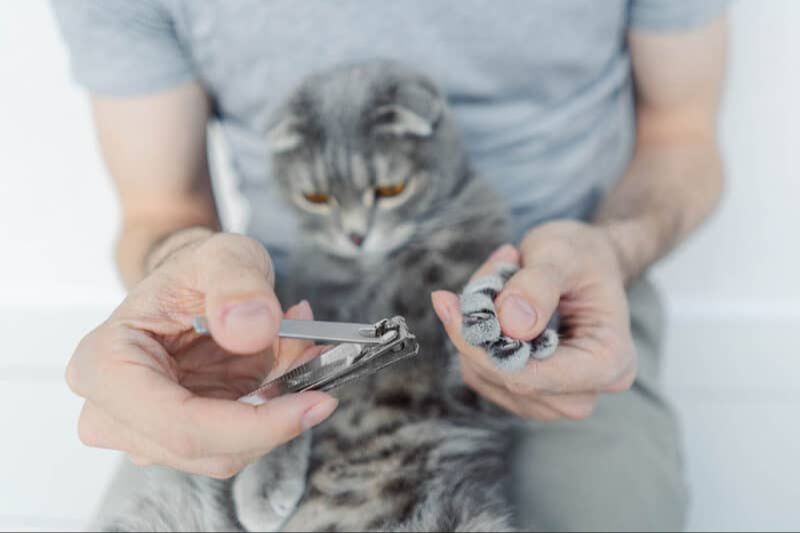Do Cat Claws Fall Out?
Cat claws naturally fall out over time as part of the normal growth process. Cat claws consist of a hard keratin outer covering that protects the living tissue inside. This keratin covering, or claw sheath, grows continuously throughout a cat’s life, with new layers growing underneath and pushing the old layers out.1
The old outer layers of the claw sheath will eventually get pushed out and shed off as the new keratin emerges. This is similar to how human fingernails and toenails grow and shed dead layers over time. For cats, shedding usually occurs every 4-6 weeks for the front claws and 8-12 weeks for the rear ones.2
Kittens under 6 months old will shed their claw sheaths more frequently as their claws grow rapidly during development. Adult cats over 1 year old will shed on a more consistent timeline. Claw shedding is a natural process that allows the claw to fully regenerate with healthy new tissue.
Kitten Claws
Kittens are born with claws that are initially quite sharp but also soft and pliable. These milk teeth and claws allow kittens to nurse from their mother and grip objects. Within the first few weeks of life, kittens will begin shedding their claws frequently as they grow. The keratin material that makes up the claws will routinely die off and be replaced with new growth.
During the rapid growth phase while kittens are under 6 months old, their claws can shed every 2-4 weeks. This frequent shedding allows the claws to be replaced with larger, stronger claws as the kitten matures. It’s normal for kittens at this young age to frequently have loose or lost claw sheaths.

Kittens learn to scratch objects in order to help remove the dead claw sheaths. Vertical scratching posts are ideal to allow gravity to help pull off the old claw as the new one emerges. Pet owners may find loose claw sheaths around scratching posts or cat trees as evidence of this normal claw shedding process.
Adult Cat Claw Growth
A cat’s claws are composed of keratin, the same protein that makes up hair and nails. The claws originate from the terminal phalanges, or outermost bones, in a cat’s toes. Cats have five toes on their front paws and four on the back paws, with a claw emerging from each toe.
As the claw grows, it extends beyond the bone to form the visible nail. The growth process occurs from within the germinal matrix, part of the claw bed. New keratin is produced in the germinal matrix and pushes the old claw material outwards. This is what causes a cat’s claws to shed and be replaced by new growth over time.
According to https://www.richellusa.com/cutting-a-cats-claws-the-how-and-why/, the claw growth occurs in layers. The outer layer is shed during scratching to expose sharp new claw underneath. This natural shedding process allows a cat’s claws to remain pointed and functional.
Shedding the Claw Sheath
A cat’s claws have a clear, hardened outer layer called the claw sheath. This covers and protects the claw while it’s growing in. As a new claw grows underneath, the old claw sheath loosens and eventually falls off (source: https://www.softpaws.com/why-do-my-cats-claws-shed/).
The claw shedding process happens regularly as the cat’s claws grow. Cats have 18 claws that need to shed these outer sheaths. The old sheaths becoming loose and falling off allows the newer, sharper claws underneath to emerge. This is a natural process that happens as the cat’s claws grow in layers.
Claw Shedding Timeline
On average, cat claws shed and regrow every 4-6 weeks. This is necessary for the claws to stay sharp.
The front claws tend to shed more frequently than the back claws. Front claws are used more often for scratching, climbing, and gripping, so they become dull faster. The back claws stay sharper for longer since they are not used as much.
Kittens will shed claws more frequently as they grow, while older cats’ claw shedding slows down. Indoor cats may take longer to shed claws since they have less opportunity to scratch them dull.
You can track your cat’s claw shedding by looking for discarded claw sheaths around scratching posts or furniture. Keep an eye out for front claws looking blunt or ragged, a sign that shedding is imminent.
Shedding is a healthy part of the claw growth cycle. As long as your cat is shedding normally and isn’t showing signs of pain or discomfort, there’s no need for concern.
Signs of Natural Claw Shedding

There are a few signs that indicate your cat’s claws are naturally shedding their outer sheaths:
– Claw sheaths will start peeling or loosening at the tip. You may see the sheath separating and starting to come off.[1]
– You’ll find shed sheaths around your home as your cat’s claws fall off. Look for small strips of clear keratin on the floor or furniture.[2]
– Cats will often chew and nibble on the loose sheaths to help remove them. You may catch your cat biting at their claw tips.
– The new claw underneath will look sharp, smooth and pink or white once the old sheath has shed.
Shed sheaths are a normal part of your cat’s claw health. As long as the sheaths come off easily and new claws look healthy, there’s no cause for concern.
Helping the Claw Shedding Process
Trimming your cat’s claws regularly can help speed up and facilitate the shedding process [1]. When trimming, be careful not to cut into the quick, the inner part of the claw which contains blood vessels and nerves. Only trim off a small amount from the sharp tip of each claw.
Providing adequate scratching surfaces is also important for helping claws shed properly. Scratching helps remove the dead outer sheaths. Vertical scratching posts and horizontal scratching boards allow cats to hook their claws and pull down or back, working the old sheaths off. Place scratching surfaces in areas your cat already likes to scratch and reward them for using these appropriate surfaces.
Scratching is a natural behavior for cats. Allowing them outlets to scratch helps satisfy this instinct in a manner that keeps their claws healthy.
Potential Problems with Claws
A cat’s claws can sometimes develop issues that require attention. Two potential problems with claws are overgrown or ingrown claws, and claw injuries or infections.

Overgrown claws occur when a cat’s claws are not worn down naturally through scratching and activity. The claws can curl and grow into the paw pads or twist sideways, becoming ingrown. According to Wag Walking, overgrown claws may cause difficulty walking, swelling and inflammation around the nails, and pain in the paws. Treatment involves trimming the overgrown portions of the claw.
Cats can also experience injuries and infections of the claw and nail bed. These are often caused by trauma from catching or snagging a claw. Signs include excessive licking or biting at the claws, separation or peeling of the claw, and swelling, redness, and pain around the nail. These conditions require veterinary treatment, which may include antibiotics, antimicrobial washes, or in severe cases, claw removal. Preventing injuries and keeping the claws clean and dry can help avoid infections.
When to See the Vet
It’s important to monitor your cat’s claws and nail beds closely. If you notice any signs of infection, cracking, bleeding, limping, or pain associated with the claws, it’s best to have a veterinarian examine them. Some signs that indicate a vet visit is needed include:
– Severe cracking or splitting of the claw that extends into the nail bed according to VCA Animal Hospitals. This can allow bacteria to enter and cause an infection.
– Bleeding around the nail that doesn’t stop. Persistent bleeding could mean a nail bed injury.
– Swelling, redness, pus, or discharge around the nail. These are signs of a bacterial or fungal claw infection.
– Limping, chewing, or licking the paw frequently. Your cat may be experiencing pain.
– Loss of a nail or part of a nail. The vet can bandage the area and monitor healing.
– Overgrown nails that are curved and no longer shedding naturally.
Your vet can diagnose the cause of any claw issues and provide appropriate treatment to relieve pain and resolve infections. This may include antibiotics, antifungal medication, and bandaging. Leaving claw problems unchecked can result in a great deal of discomfort for your cat. It’s better to seek prompt veterinary attention.
Keeping Claws Healthy
It’s important to maintain your cat’s claws for their health and comfort. Here are some tips for keeping your cat’s claws in good condition:

Regularly trim overgrown claws. Cat claws continuously grow and shed layers. If the claws get too long, they can snag and tear. Use special nail clippers designed for cats and trim just the sharp tip of the nail, avoiding the pink quick inside. Trimming every 2-3 weeks helps control sharp points. [1]
Provide appropriate scratching surfaces. Scratching is a natural behavior for cats to remove dead sheaths and mark territory. Make sure your cat has sturdy scratching posts and boards around your home. Place them in areas your cat already likes to scratch to encourage use. [2]
Watch for signs of issues. Look for cracked, brittle, or deformed claws which could indicate disease or injury. Swelling around the paws or unusual discharge can also signify problems. Limping or sensitivity when touched may mean an embedded foreign object. Seek veterinary help if you observe any abnormalities.

